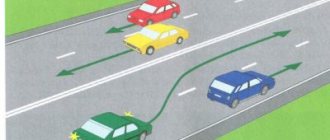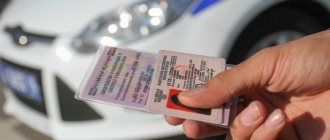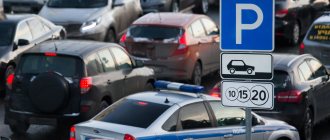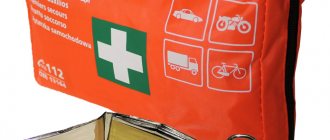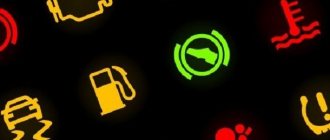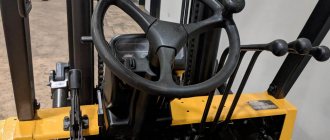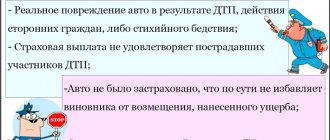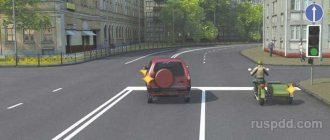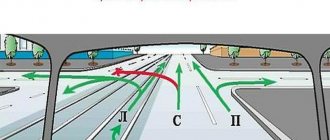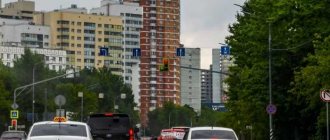Typically, turning around is one of the unsafe maneuvers. If you are a beginner or inexperienced driver, it will be better to make a U-turn outside the intersection, because turning at an intersection is a rather difficult maneuver. There is a way out of this situation; you can turn left and, outside the intersection, turn around where it is easier to do this, for example, in the yard or in the parking lot. But sooner or later you will have to learn to turn around, and therefore now we will get acquainted with the general theory in detail, you will just have to do it yourself in practice.
Symbolically, the reversals can be divided into two groups:
- U-turns within the intersection
- U-turns outside the intersection
The most important thing when turning is that you are clearly visible to other motorists and, accordingly, to you.
Maneuvering - Traffic rules establish strict standards of behavior
The collection of traffic rules has a separate large chapter devoted to maneuvering, but administrative language does not always contribute to memorization and assimilation, so we will talk about this in a more free form and, so to speak, from the everyday side of the issue. Let's start with the main thing. This is a designation for maneuvering. The rules strongly recommend that you always indicate your intentions clearly, precisely and in a timely manner . For this purpose, the car has special lights at the front and rear. If they don't work, you can do it by hand through the open side window.
The basic pattern of giving signs is that this must be done immediately before the maneuver, but not at the moment of its implementation. It is difficult to name a time interval, since it does not exist, sometimes the driving culture welcomes early signals so that those behind can change lanes and not break their pace, and sometimes signals turned on too early can mislead them. For example, you want to turn left and showed the signal too early, and there are at least three left turns in front of you, but you did not attach any importance to this. But the driver behind you will not know whether he is on the way with you or you are turning earlier, you need to change lanes and overtake, or it is more practical to wait until you turn, etc.
In addition, in no case does a timely signal give you an advantage in traffic, so when maneuvering you should respect not only the calmness of neighboring drivers, but also the principle of accident-free traffic in general. When changing lanes, you are like a guest on a new lane and road, which means you must respect the order that has already developed there. The advice of every experienced motorist is to make as few movements as possible on the road, because today the density of cars in cities, especially large ones, is so high. Therefore, think over your trajectory much in advance in order to be less likely to disturb other road users in an emergency.
Turns, U-turns and lane changes correspond to the turn indicator on the side of the car in which direction you intend to make the maneuver. When stopping, the turn signal is in the direction where you plan to lean the tired body of the car (for example, the side of the road/curb), and when starting off, in the opposite direction from the curb. Hand signals: stop - straight arm up, direction of maneuver - straight arm in the direction of the maneuver or bent arm at the elbow opposite to the maneuver.
It's time to make U-turns outside the intersection.
First, consider the case of a U-turn on a two-lane road with a broken dividing line or no dividing line at all. The main condition for turning around on such a road is that this place should be clearly visible from all sides.
If the roadway is divided by a double solid or wide dividing strip, then you cannot make a turn in this part. In such cases, there are special places, marked with signs and markings, where you can turn around.
A U-turn can also be made through tram tracks if there are no prohibiting signs or special markings and the rails are in the same plane as the road. To make a U-turn, you need to change lanes to the far left, allowing a passing tram to pass, and enter the tram line of the same direction. You must give way to all oncoming traffic. If you do not interfere with anyone, make a U-turn.
U-turn within the intersection.
First of all, you need to focus on signs and markings. As a reminder, just because these symbols tell you not to turn left does not mean you can't make a U-turn on that stretch of road.
The rules do not have clear instructions on how to correctly perform this maneuver, but there is a basic instruction in which vehicles must remain in their lane and not enter the lane of oncoming traffic.
To make a U-turn, you need to take the extreme left position on the lane, turn on the left turn signal and drive to the center of the intersection at the permission signal. If you do not obstruct anyone, complete the maneuver. If you did not have time to make a turn at your traffic light, you can safely complete the maneuver, since other drivers are obliged to let you pass. But you need to be careful, because for other motorists the permit signal will be on, and you may not be noticed.
Now let's look at U-turns at an uncontrolled intersection. The main catch is which road you are on: main or secondary. It will not be easy to turn around from a secondary road, since those on the main road have the advantage. And if the intersection is busy, then this becomes almost impossible. And therefore it is better to choose a different place to turn around. If you are moving along the main road, then a U-turn is usually performed, just like a left turn. You take the extreme left position, turn on the turn signal to the left, and if you do not interfere with traffic that has the right of way, turn around.

